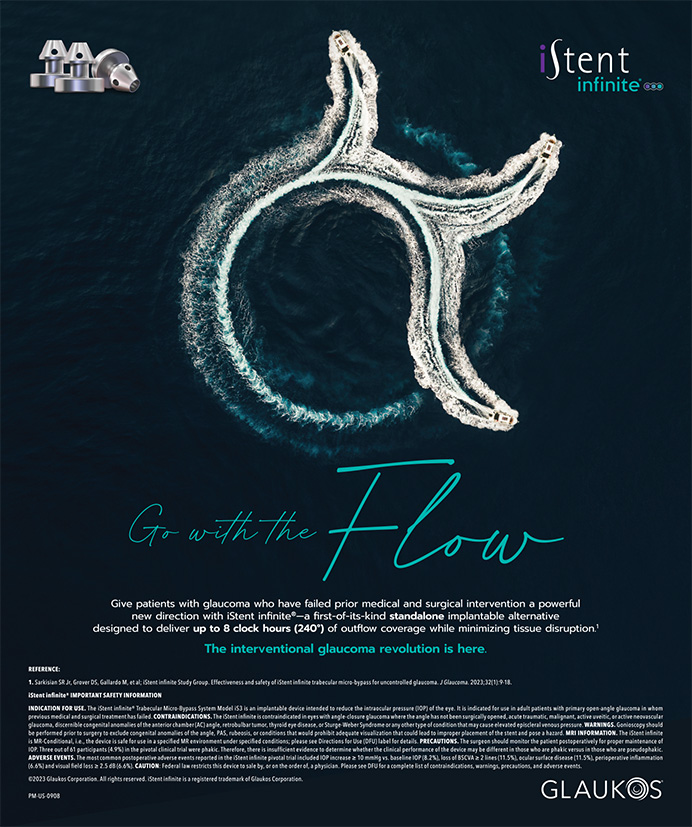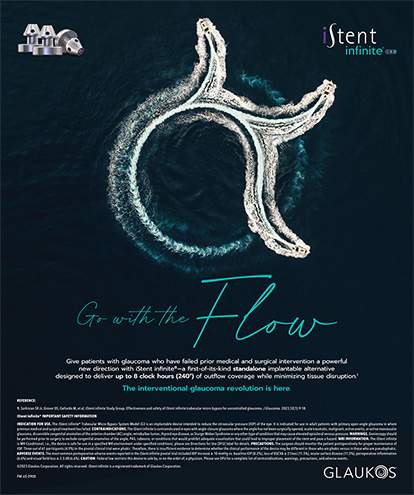



William F. Wiley, MD: Having a patient return to your practice after refractive surgery unhappy with their outcome is one of the most high-pressure situations we face. Conversations with these patients can be tense, and they may not realize that enhancement procedures are commonly performed after refractive surgery. Luckily, there are several ways to fine-tune postoperative results with either cornea- or lens-based procedures. During this discussion, we’ll talk about the different enhancement strategies and go through some specific case examples to see how each of us would approach them.
Blake K. Williamson, MD, MPH, MS: This is an important topic. I believe that the way a surgeon approaches an enhancement procedure is a huge differentiator between a good refractive surgeon and a great refractive surgeon. A great refractive surgeon does not leave a patient on the 10-yard line; they get them into the end zone.
Priya M. Mathews, MD, MPH: I agree, and knowing how to approach enhancements gives you the confidence to do more refractive surgery procedures because you understand how to fix most problems that patients experience postoperatively.
Arjan Hura, MD: I think this is an important topic. There are a lot of nuances with enhancements, and knowing how to pick the right solution for each patient is a differentiator between those who dabble in doing a little bit of LASIK and PRK and those who are truly comprehensive refractive surgeons and a master of the refractive surgery subspecialty.
REFRACTIVE ENHANCEMENTS
Dr. Wiley: Let’s get to the first case. A 38-year-old patient who had myopic LASIK about 8 months ago presents with complaints of decreased vision. The examination reveals that her refraction regressed to -1.00 D. Blake, what is your best approach here? Would you change anything with your programmed laser settings, and would you use a wavefront-guided or wavefront-optimized technique?
Dr. Williamson: This scenario is similar to my clinical course as a LASIK patient. I underwent LASIK for -2.50 D of myopia when I was 37 years old. I ended up -0.75 D in one eye with a UCVA of 20/20 and plano in the other with a UCVA of 20/10. My vision in the 20/20 eye, however, was blurry, and the best line that I could see crisply with that eye was 20/40. Going through this personally totally changed my approach to enhancements. Now, I will do a contact lens trial and consider performing an enhancement for a residual error as low as -0.50 D.
For the 38-year-old you described, to some extent, my approach would depend on where they started, what their refraction in the second eye is postoperatively, and what they do for a living. Were they -7.00 D preoperatively? Postoperatively, are they -0.50 D or plano in one eye and -1.00 D in the other? Do they value their near vision? For example, a tax attorney who works with spreadsheets constantly or a ferocious reader who doesn’t want to deal with reading glasses may not mind a little bit of myopia. Most young people, however, want to get all the way to plano. For the last group, I would do an enhancement after having a conversation with them about delaying reading glasses for a little while.
Dr. Mathews: The timing of this case is uncanny because tomorrow I’m performing a LASIK enhancement on a 35-year-old who is unhappy with his vision after surgery to correct -8.00 D of myopia. I waited about 6 months until there were at least two stable refractions a few weeks apart and the corneal topography was normal. Most patients in their 30s don’t tolerate even slight residual myopia. I have no problem performing an enhancement in that situation. The conversation with patients in their 40s would be very different.
It’s important to explain to patients ahead of refractive surgery that there is a chance they will need an enhancement. This eliminates the surprise if an enhancement is needed. Postoperatively, it’s important to exude confidence when you discuss enhancement strategies with patients. I start by telling them that I perform enhancements regularly and then explain that a thorough examination and contact lens trial will help us get the exact prescription they need to resolve their problem.
For the 38-year-old patient in this scenario, I would lift the flap and look for and remove any epithelial ingrowth. I would use a wavefront-optimized approach.
Dr. Wiley: Great comment about being on the lookout for epithelial ingrowth. Another thing that comes to mind is that enhancements involve removing somewhere between 15 and 18 µm of epithelium for every 1.00 D of correction. A customized treatment is a great approach to minimizing the chance of overtreating the eye.
How would your approach to this case change if the same patient were left with a residual error of 1.00 D instead of -1.00 D. They were myopic before surgery, but 2 months postoperatively, they report having blurry vision at both distance and near.
Dr. Hura: If the patient was being monitored and an early trend toward hyperopia was noted in the postoperative period, one way to proceed is to back off on the frequency of the topical steroid and keep the NSAID and/or use a method known as contact lens–assisted pharmacologically induced keratosteepening (CLAPIKS). CLAPIKS combines the use of a contact lens of the same power as the residual hyperopic refractive error with topical NSAID therapy to theoretically reshape the cornea by inducing localized epithelial proliferation and thickening of the anterior stroma. The contact lens creates local hypoxia and increases the NSAID contact time. Together, this leads to localized epithelial changes. It takes only 12 to 14 µm of change in epithelial thickness to induce about 1.00 D of change in refractive error. When I first heard about the technique, I was skeptical. But, in my experience, CLAPIKS can often spare patients the need for a second surgery.
If the timing were 6 to 12 months after surgery, then I would lift the flap and perform a LASIK enhancement. I would not perform PRK because results from hyperopic PRK are unreliable. I also likely would not cut back as much on the ablation for a hyperopic enhancement as I would for a myopic enhancement because only the periphery is being treated. Finally, I think that epithelial mapping can be helpful in this situation because it can show the degree of zonal epithelial hyperplasia, which can be helpful to decide how much to potentially cut back on the ablation that is going to be programmed.
Dr. Wiley: How would your approach to the enhancement change if the same 38-year-old patient came back at 6 years instead of less than 1 year after surgery? They had -5.00 D of myopia before LASIK and are now -1.00 D. They say to you, “Doc, my LASIK wore off.” Would you cover the cost of the enhancement, or would you charge for it? Also, what treatment would you select in that scenario?
Dr. Williamson: At our practice, all enhancements within the first year of primary LASIK are covered. For the patient you’re describing, we would charge them full price. I would have a long talk with them, however, and make sure they understand the trade-off of distance vision for near vision. If that was something they could accept, I would perform PRK. I don’t like to lift the flap past 2 years and prefer to do it within the first year.
Dr. Wiley: Let’s say the patient’s epithelial map shows an average thickness of 70 µm, so there’s a little bit of epithelial hyperplasia. Would you treat the full -1.00 D?
Dr. Williamson: If you do a PRK and remove the epithelium, the patient will end up hyperopic. I’d probably back off to -0.50 or -0.75 D.
Dr. Hura: Another approach that some surgeons use is to remove the epithelium and apply mitomycin C to potentially prevent exuberant recurrent epithelial hyperplasia. I’m not sure how much this has been validated. In the case here, I would get epithelial mapping to see if there is a large area of central epithelial hyperplasia. If there is, I would back off on the treatment.
Dr. Wiley: What if a patient had PRK because they were in the military rather than because they had a thin cornea or dry eye disease? Ten years later, they present with regression. The cornea is more than 500 µm thick, and their refraction is -1.00 D of myopia. Would you do PRK again or consider LASIK on top of the PRK?
Dr. Hura: I just had a case like this. The patient had undergone PRK several years ago while he was in the service and regressed to around -1.00 D. Now that he was out of the service, he wanted to get his pilot’s license. The corneas were pristine on topography and tomography, and epithelial mapping was relatively normal. I felt that doing a PRK enhancement on top of his prior PRK might lead to variability in healing and outcome versus a secondary LASIK procedure after the primary PRK, which would give a more predictable result. I performed LASIK and made a slightly thicker flap than I normally would (120 vs 90 µm) because there was a little bit of epithelial hyperplasia that could be seen on epithelial mapping and I wanted to minimize the chances of suction loss. The patient did great.
Dr. Wiley: Is there an age at which you might move to a lens-based approach?
Dr. Williamson: I would consider it in this case. Rather than do an ablation on top of an ablation and knowing the patient will probably have a custom lens replacement within 3 to 13 years, I’d go straight for the bag now.
Dr. Mathews: I prefer a lens-based enhancement approach for patients in their mid-40s or 50s. Otherwise, the patient may end up with three ablation procedures: the original surgery, a postrefractive surgery enhancement, and potentially an enhancement after their cataract surgery assuming they select a multifocal IOL.
Dr. Wiley: I’m somewhere in the middle. In theory, a lens-based approach is great. I feel more confident in hitting the target now with the IOL options we have, such as the Light Adjustable Lens (LAL; RxSight), IC-8 Apthera (Bausch + Lomb), and many of the extended depth of focus IOLs. What IOLs do you use in a postrefractive eye, Blake?
Dr. Williamson: The Tecnis Symfony OptiBlue (Johnson & Johnson Vision) is forgiving, and it’s become my go-to IOL. If the patient prefers monovision or has a complex cornea, then I would use the LAL with micromonovision.
Dr. Mathews: I prefer the LAL in these patients. I also implant a lot of Symfony and Tecnis Synergy (Johnson & Johnson Vision) lenses, but with these IOLs, it is crucial that you hit your target because they are less tolerant of refractive errors.
LENS-BASED ENHANCEMENTS
Dr. Wiley: This is a great segue into our discussion of enhancing lens-based procedures. Patient expectations after cataract surgery are at an all-time high. It is therefore crucial for us to hit the target refraction. As I did for refractive enhancements, I will throw out a few scenarios for us to discuss.
A 70-year-old with a history of cataract surgery and toric IOL implantation presents with a refraction of +1.00 -2.00 x 180º. Their toric IOL appears to be off axis by about 20º, and the astigmatism is not corrected. What’s your go-to method for fixing the problem?
Dr. Williamson: I would rotate the IOL as soon as I could. Some of the newer lenses are super sticky, and they can be harder to rotate the longer you wait.
Dr. Mathews: I’ve done LASIK on these patients, too. Sometimes, it can be the better approach in my hands, especially for eyes with a small pupil or those that might need a touch-up regardless of the IOL rotation.
Dr. Wiley: I try to rotate the IOL first. Worst case scenario, the patient still has a refractive error after the IOL is rotated back to the intended axis, and I perform a laser enhancement.
Dr. Hura: In most cases, I would rotate the IOL back into position first, but like Priya said, sometimes doing LASIK first is the right option. If a patient has a spherical equivalent of essentially plano and they are not a good LASIK candidate, you could still do PRK and have a pretty good outcome. Surgery can be anxiety-provoking for patients, and the thought of having to go back to the OR—even for something as simple as rotating a toric IOL—can be a lot to take in for patients. Some patients are much more amenable to just addressing the refractive error in the laser suite.
The other thing I would bring up is timing. Like Blake said, I would rotate the IOL as quickly as possible, but I would wait several months before performing a laser vision correction enhancement to make sure the refractive error is stable. If the patient really wants the refractive error addressed as soon as possible, then rotating the IOL would be my preference.
Dr. Wiley: Let’s review another scenario. A 70-year-old patient received a trifocal IOL, but at 6 months, their prescription is 1.00 or 1.50 D of sphere. The patient reports blurry distance vision.
Dr. Williamson: I would explant it, again, as soon as I could. Even if the patient is 2 months out and they’re a solid 1.50 D, that’s a situation where I’m not going to make them wait months before I explant the lens because I know they’re unhappy every single day. I would not do a hyperopic ablation over a trifocal IOL.
Dr. Wiley: In my experience, a hyperopic treatment of the cornea—particularly hyperopic PRK—has the tendency to regress over time.
Dr. Mathews: I am curious: Is there a maximum amount of time after which you no longer consider exchanging the IOL?
Dr. Williamson: If a patient hasn’t had an Nd:YAG treatment, then I feel pretty confident that I can explant the IOL within the first year or 2. Worst case scenario, if I’m in the OR and can’t get the lens out, I would amputate the haptics and place a monofocal IOL in the sulcus. Beyond 3 years, I think explanting the IOL can leave patients worse off than what they started with.
Dr. Wiley: I agree. These are tough cases, and a lot of times I don’t know what I’m going to do until I’m in the eye—either a lens exchange or a piggyback IOL. I’ve explanted IOLs as far out as 4 years. I tell patients I’m going to try to get it out but, if I can’t, I will implant another lens in the sulcus.
Let’s move to the last case, which is a 30-year-old who received an EVO Toric ICL (STAAR Surgical). The lens rotated 90º postoperatively, and as a result, the cylinder doubled. The ICL size is 12.6 mm, and the vault is 100 µm.
Dr. Williamson: Typically, I do the easiest thing first. The easiest thing to me here is just rotating the ICL back into position. If the eye were larger and the ICL kept rotating out of position, I would explant the lens and correct the astigmatism with a LASIK enhancement. With that said, I have yet to rotate an EVO Toric ICL. Also, I’m less concerned about a low vault with the EVO design, especially when I’m doing a rotation.
“I believe that the way a surgeon approaches an enhancement procedure is a huge differentiator between a good refractive surgeon and a great refractive surgeon. A great refractive surgeon does not leave a patient on the 10-yard line; they get them into the end zone.”
– Blake K. Williamson, MD, MPH, MS
“Postoperatively, it’s important to exude confidence when you discuss enhancement strategies with patients. I start by telling them that I perform enhancements regularly and then explain that a thorough examination and contact lens trial will help us get the exact prescription they need to resolve their problem.”
– Priya M. Mathews, MD, MPH
“Enhancements involve removing somewhere between 15 and 18 µm of epithelium for every 1.00 D of correction. A customized treatment is a great approach to minimizing the chance of overtreating the eye.”
– William F. Wiley, MD
“I would encourage those who do not offer enhancements or are not comfortable performing IOL exchange, LASIK, SMILE, or PRK to visit another surgeon who does, attend meetings and conferences, or have conversations like this to acquire the knowledge and learn the skills needed to perform enhancements.”
– Arjan Hura, MD
Dr. Mathews: A vault of 100 µm doesn’t worry me, but in this situation I would lean toward exchanging the ICL for a bigger model, probably the 13.2 mm.
Dr. Wiley: Arjan, how would you proceed if the astigmatism doubled and the ICL were sitting vertically but was stable?
Dr. Hura: The question becomes what happens if you rotate the ICL and it rotates to the same vertical position again? I feel that’s a good indicator of what their sulcus and ciliary body anatomy is like. One option is to reach out to STAAR and ask them to manufacture an ICL with the astigmatism correction reoriented for the axis of where the ICL keeps rotating to. The other thing is this: Sometimes, you need to know when to call it quits. If you’ve been back in an eye twice to rotate an ICL or exchange it for a bigger or smaller size, consider a spherical ICL of the appropriate size and then a laser vision enhancement afterward to correct the residual astigmatism if the cornea allows.
Dr. Wiley: I’ve done SMILE over an ICL to correct residual sphere and cylinder. A certain amount of myopia is required even to proceed with SMILE, so the eye is undercorrected with a spherical EVO, and the residual astigmatism is corrected with the laser procedure. I can remember one specific case where a toric ICL kept rotating out of position. I exchanged it for a spherical ICL with a little bit lower power to leave room for SMILE to correct the residual sphere. In these situations, you want to make sure, if you’re going back into the eye, you have a plan that makes sense and the patient has bought into it.
What are your final thoughts on enhancements for cornea- and lens-based surgery?
Dr. Williamson: A lot of cataract surgeons do toric and multifocal IOLs, but they don’t do enhancements to the degree that they’re probably needed. For those who might not be as confident with the idea of offering enhancements to patients who are mildly to moderately happy but not quite ecstatic, I would remind them that those patients are sharing their experiences with other people in the community. That won’t build your practice or the refractive surgery specialty. Making people ecstatic, however, will build your practice and the specialty. There is a difference between 20/happy and 20/hell yes, and I know that from my own LASIK experience.
Dr. Mathews: Not everyone has the necessary tools to enhance patients in their own practice, and that’s OK. I would suggest these individuals partner with a refractive surgeon whom they trust. Our practice works in this way with several surgeons in our area. We speak highly of each other and respect each other’s strengths. We all want to have happy patients, and partnering with someone who can help your patients reach their target refraction is a win-win. Additionally, it’s important to tell patients before surgery that you will do the best you can to get them glasses free but that there’s a chance they may need glasses after surgery. It should be documented in your consultation notes so there is no surprise after surgery.
Dr. Hura: I would encourage those who do not offer enhancements or are not comfortable performing IOL exchange, LASIK, SMILE, or PRK to visit another surgeon who does, attend meetings and conferences, or have conversations like this to acquire the knowledge and learn the skills needed to perform enhancements. Being able to offer an enhancement to a patient whose outcome is suboptimal can be the difference between an okay result and a great result. Don’t feel like you can’t learn something new if you’ve been out in practice for many years or if there is a refractive surgeon in town who can take care of enhancements for you. The patient will love it if you, the primary surgeon, continue the journey with them, perform the enhancement, and get them over the finish line. I think everyone who implements this mentality finds their practice more fulfilling.
Dr. Wiley: Thanks for such an informative discussion. It’s safe to say that enhancements are a normal part of the postoperative process for many patients. Getting patients to 20/happy may not be good enough, as Blake put it, and thus requires us to embrace enhancements and do what’s needed to get patients where they want to be.




